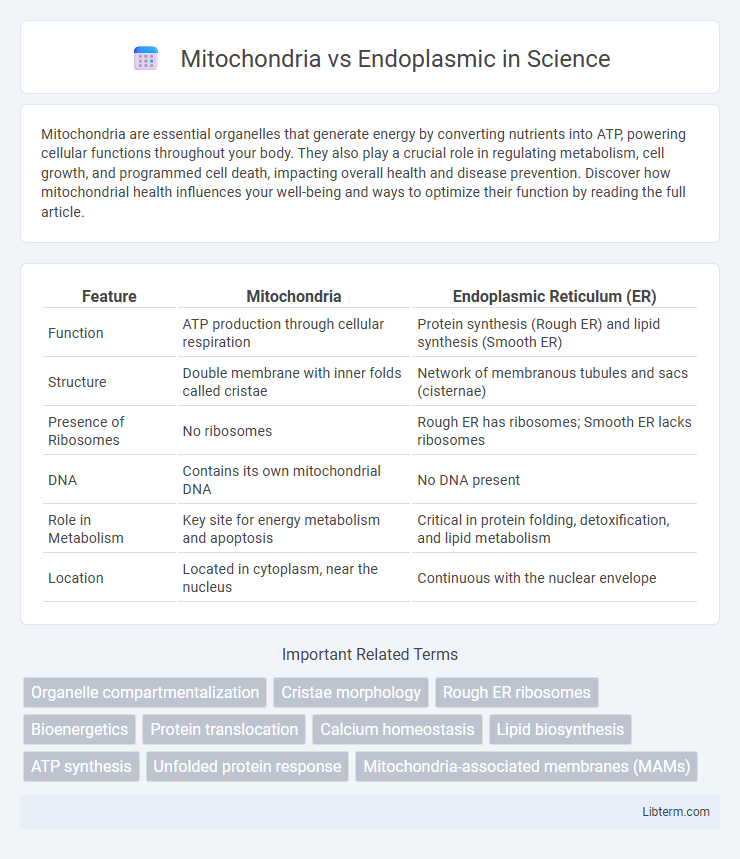Mitochondria are essential organelles that generate energy by converting nutrients into ATP, powering cellular functions throughout your body. They also play a crucial role in regulating metabolism, cell growth, and programmed cell death, impacting overall health and disease prevention. Discover how mitochondrial health influences your well-being and ways to optimize their function by reading the full article.
Table of Comparison
| Feature | Mitochondria | Endoplasmic Reticulum (ER) |
|---|---|---|
| Function | ATP production through cellular respiration | Protein synthesis (Rough ER) and lipid synthesis (Smooth ER) |
| Structure | Double membrane with inner folds called cristae | Network of membranous tubules and sacs (cisternae) |
| Presence of Ribosomes | No ribosomes | Rough ER has ribosomes; Smooth ER lacks ribosomes |
| DNA | Contains its own mitochondrial DNA | No DNA present |
| Role in Metabolism | Key site for energy metabolism and apoptosis | Critical in protein folding, detoxification, and lipid metabolism |
| Location | Located in cytoplasm, near the nucleus | Continuous with the nuclear envelope |
Introduction to Mitochondria and Endoplasmic Reticulum
Mitochondria are double-membrane organelles known as the powerhouse of the cell, responsible for generating ATP through cellular respiration. The endoplasmic reticulum (ER) is an extensive network of membranous tubules involved in protein synthesis and lipid metabolism, divided into rough ER with ribosomes and smooth ER without ribosomes. Both organelles play crucial roles in maintaining cellular function and energy metabolism.
Cellular Location and Structure Comparison
Mitochondria are double-membraned organelles primarily located in the cytoplasm and characterized by an outer smooth membrane and a highly folded inner membrane forming cristae, which increase surface area for ATP production. The endoplasmic reticulum (ER) exists as a network of membranous tubules and flattened sacs dispersed throughout the cytoplasm, divided into rough ER, studded with ribosomes for protein synthesis, and smooth ER, which lacks ribosomes and functions in lipid metabolism and detoxification. Unlike the spherical mitochondria, the ER's extensive, interconnected membrane system facilitates intracellular transport and structural support within the cell.
Mitochondria: The Powerhouse of the Cell
Mitochondria serve as the primary sites for ATP production through oxidative phosphorylation, powering cellular activities. Unlike the endoplasmic reticulum, which is involved in protein and lipid synthesis, mitochondria regulate energy metabolism and apoptosis. Their unique double membrane and mitochondrial DNA enable efficient energy conversion and genetic autonomy within eukaryotic cells.
Endoplasmic Reticulum: Types and Key Functions
The endoplasmic reticulum (ER) is a vital cellular organelle categorized into two types: rough ER, which is studded with ribosomes and primarily involved in protein synthesis and folding, and smooth ER, which lacks ribosomes and functions in lipid synthesis, detoxification, and calcium ion storage. The rough ER synthesizes membrane-bound and secretory proteins, while the smooth ER plays a critical role in metabolizing carbohydrates and detoxifying drugs and poisons. Together, these functions support cellular homeostasis and the synthesis of essential biomolecules, distinguishing the ER's role from that of mitochondria, which specialize in energy production.
Genetic Material: Mitochondrial DNA vs ER’s Genomic Role
Mitochondria contain their own circular mitochondrial DNA (mtDNA), encoding essential genes for oxidative phosphorylation and energy production, independent of the cell's nuclear genome. In contrast, the endoplasmic reticulum (ER) lacks its own DNA and relies entirely on nuclear-encoded genes for synthesizing proteins and lipids. This distinction highlights mitochondria's unique semi-autonomous role in cellular genetics versus the ER's dependency on nuclear genomic information.
Energy Production vs Protein and Lipid Synthesis
Mitochondria serve as the cell's powerhouse by converting nutrients into ATP through oxidative phosphorylation, driving energy production essential for cellular functions. In contrast, the endoplasmic reticulum specializes in protein and lipid synthesis; the rough ER contains ribosomes for translating proteins, while the smooth ER synthesizes lipids and detoxifies substances. This division of labor highlights mitochondria's role in energy metabolism versus the endoplasmic reticulum's function in biosynthetic and processing activities within eukaryotic cells.
Interaction and Communication Between Organelles
Mitochondria and the endoplasmic reticulum (ER) engage in critical interactions that regulate cellular metabolism and calcium signaling through specialized structures called mitochondria-associated membranes (MAMs). These contact sites enable the exchange of lipids and calcium ions, facilitating energy production and apoptosis regulation. Disruptions in mitochondria-ER communication are implicated in neurodegenerative diseases and metabolic disorders, highlighting their essential coordination in maintaining cellular homeostasis.
Disorders Linked to Mitochondrial vs ER Dysfunction
Mitochondrial dysfunction is primarily linked to disorders such as mitochondrial myopathies, Leigh syndrome, and MELAS syndrome, which result from impaired energy metabolism and ATP production. Endoplasmic reticulum (ER) dysfunction contributes to diseases like cystic fibrosis, Alzheimer's disease, and ER stress-related diabetes through disrupted protein folding and calcium homeostasis. Both organelles play crucial roles in cellular health, but their dysfunction leads to distinct pathological conditions characterized by unique molecular mechanisms.
Recent Research and Scientific Advances
Recent research highlights the distinct yet interconnected roles of mitochondria and the endoplasmic reticulum (ER) in cellular metabolism and calcium signaling, revealing new insights into their dynamic membrane contact sites called mitochondria-associated membranes (MAMs). Advances in imaging and molecular biology have uncovered critical mechanisms by which these organelles coordinate lipid exchange and bioenergetics, influencing cellular stress responses and apoptosis. Emerging evidence suggests that dysfunctions in mitochondria-ER crosstalk contribute to neurodegenerative diseases, informing potential therapeutic targets.
Conclusion: Key Differences and Biological Impact
Mitochondria generate cellular energy through ATP production via oxidative phosphorylation, pivotal for metabolism and apoptosis regulation, whereas the endoplasmic reticulum (ER) facilitates protein synthesis, folding, post-translational modifications, and lipid metabolism essential for cell homeostasis. The mitochondria's role in energy conversion contrasts with the ER's involvement in macromolecular synthesis and calcium storage, highlighting their complementary functions in cellular physiology. These organelles' distinct yet interdependent activities underscore their critical impact on cellular health and disease mechanisms such as neurodegeneration and metabolic disorders.
Mitochondria Infographic

 libterm.com
libterm.com